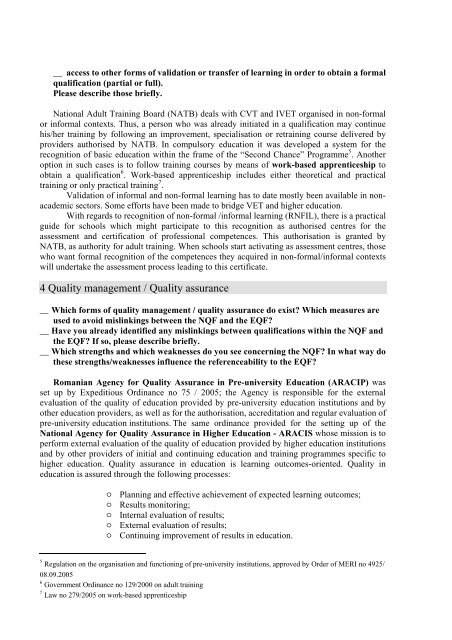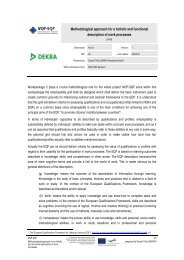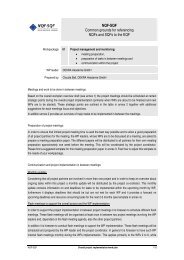Overview of National Qualification frameworks - Project-Nqf-Sqf
Overview of National Qualification frameworks - Project-Nqf-Sqf
Overview of National Qualification frameworks - Project-Nqf-Sqf
Create successful ePaper yourself
Turn your PDF publications into a flip-book with our unique Google optimized e-Paper software.
__ access to other forms <strong>of</strong> validation or transfer <strong>of</strong> learning in order to obtain a formalqualification (partial or full).Please describe those briefly.<strong>National</strong> Adult Training Board (NATB) deals with CVT and IVET organised in non-formalor informal contexts. Thus, a person who was already initiated in a qualification may continuehis/her training by following an improvement, specialisation or retraining course delivered byproviders authorised by NATB. In compulsory education it was developed a system for therecognition <strong>of</strong> basic education within the frame <strong>of</strong> the “Second Chance” Programme 5 . Anotheroption in such cases is to follow training courses by means <strong>of</strong> work-based apprenticeship toobtain a qualification 6 . Work-based apprenticeship includes either theoretical and practicaltraining or only practical training 7 .Validation <strong>of</strong> informal and non-formal learning has to date mostly been available in nonacademicsectors. Some efforts have been made to bridge VET and higher education.With regards to recognition <strong>of</strong> non-formal /informal learning (RNFIL), there is a practicalguide for schools which might participate to this recognition as authorised centres for theassessment and certification <strong>of</strong> pr<strong>of</strong>essional competences. This authorisation is granted byNATB, as authority for adult training. When schools start activating as assessment centres, thosewho want formal recognition <strong>of</strong> the competences they acquired in non-formal/informal contextswill undertake the assessment process leading to this certificate.4 Quality management / Quality assurance__ Which forms <strong>of</strong> quality management / quality assurance do exist? Which measures areused to avoid mislinkings between the NQF and the EQF?__ Have you already identified any mislinkings between qualifications within the NQF andthe EQF? If so, please describe briefly.__ Which strengths and which weaknesses do you see concerning the NQF? In what way dothese strengths/weaknesses influence the referenceability to the EQF?Romanian Agency for Quality Assurance in Pre-university Education (ARACIP) wasset up by Expeditious Ordinance no 75 / 2005; the Agency is responsible for the externalevaluation <strong>of</strong> the quality <strong>of</strong> education provided by pre-university education institutions and byother education providers, as well as for the authorisation, accreditation and regular evaluation <strong>of</strong>pre-university education institutions. The same ordinance provided for the setting up <strong>of</strong> the<strong>National</strong> Agency for Quality Assurance in Higher Education - ARACIS whose mission is toperform external evaluation <strong>of</strong> the quality <strong>of</strong> education provided by higher education institutionsand by other providers <strong>of</strong> initial and continuing education and training programmes specific tohigher education. Quality assurance in education is learning outcomes-oriented. Quality ineducation is assured through the following processes:o Planning and effective achievement <strong>of</strong> expected learning outcomes;o Results monitoring;o Internal evaluation <strong>of</strong> results;o External evaluation <strong>of</strong> results;o Continuing improvement <strong>of</strong> results in education.5 Regulation on the organisation and functioning <strong>of</strong> pre-university institutions, approved by Order <strong>of</strong> MERI no 4925/08.09.20056 Government Ordinance no 129/2000 on adult training7 Law no 279/2005 on work-based apprenticeship




